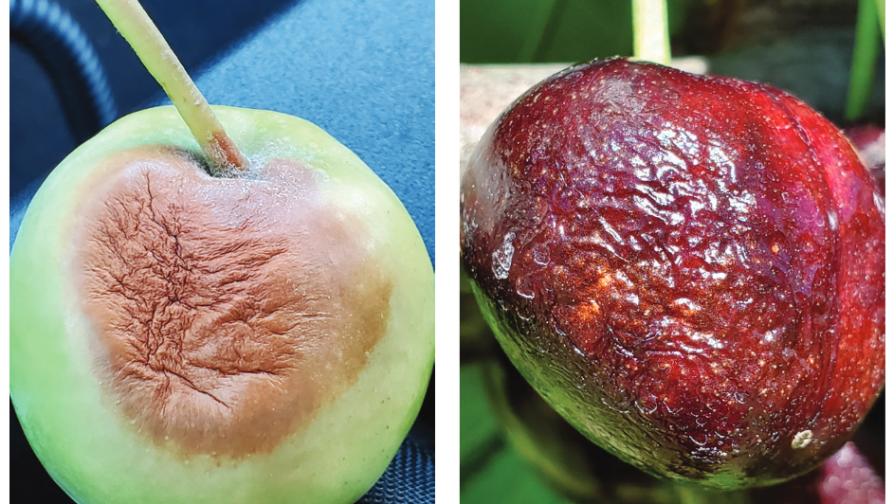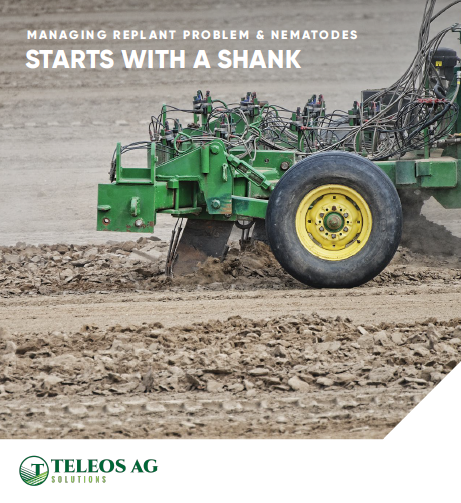2021 Heat Dome Effect Puts a Lid on Pome Fruit Postharvest Plans

Wilbur-Ellis Key Account Manager Byron Phillips took these photographs of a ‘Cripps Pink’ apple near Quincy, WA (left), and ‘Chelan’ cherry, near Desert Aire, WA (right), during the 2021 heat wave that struck the Pacific Northwest. “I could literally watch these cook and shrivel before my eyes,” he says.
Was the heat dome that struck the Pacific Northwest this summer really just a “once-in-a-millennium” event? Tom Auvil certainly hopes so.
“Once was enough for me,” the Orondo, WA, grower says.
Temperatures as high as 113°F will have that kind of effect on even the most unflappable of apple growers. The immediate damage — between late June and mid-July — was distressing at the time. Postharvest, the news isn’t much better.
Judging by the number of empty bins in his bin yards as of late October, Auvil estimates that his crop will range between short (off 5 to 8 million of the 125 million fresh) and really short (10 to 15 million off the 125 million fresh).
“The largest volume of unused bins is the largest in recent memory — 10 years, perhaps 15 years — and does not consider any packout issues that can further reduce the fresh pack volume,” he says.
Not that Auvil didn’t try to limit damage from the get-go while making the best of the dilemma.
“We did strive to pick the advanced maturity ‘Gala’ prior to the August heat and finished the ‘Gala’ harvest about 10 days after the first pass,” he says. “We left the obvious sunburn behind — about five bins per acre — and then the packouts were still off about 10% below normal for early pools.”
Meanwhile, the ‘Granny’ harvest had about 10 bins per acre put on the ground, Auvil says, and the packouts for early pool were about normal. The season pool fruit is where there is risk of delayed sunburn, Auvil says, reducing packout 25% to 30%.
“The biggest challenge, even with fruit with cooling programs, will be the more diverse maturity than usual, which makes storage more challenging,” Auvil says. “The packing lines have technology to sort senescing fruit from sound, but for varieties like ‘Gala’ and ‘Red Delicious’, the packouts can be impacted.”
BAD NEWS, GOOD NEWS
Four hundred miles southeast, in Homedale, ID, Bob Purvis dealt with 17 days of 100-degree temperatures this summer, including a high of 107°F. The long-term effects on his farm have been mixed.
“One thing I have observed is that, on the later-ripening apples, size has been consistently smaller than usual despite good leaf size and satisfactory terminal growth,” Purvis says. “The size of apples harvested in late July, August, September, and early October was a bit larger than average. What I believe is going on here is a balancing act between heat issues, which are detrimental, and large, healthy leaves on our apple trees, which are beneficial.”
With regard to his ‘Douglas’ pears, crop quality is very good, Purvis says, despite the heat of June and July.
“Pears seem to handle heat much better than do apples. There were pears this season that in past years were too poor in their flavor to sell. This year they sold well at the farmers’ market I go to,” Purvis says.
Meanwhile, bitter pit, which in past years had been a problem with ‘Honeycrisp’, was not evident this year in ‘Honeycrisp’, ‘Shizuka’, ‘Braeburn’, and 8C-28-27, which is a ‘Red Delicious’ x ‘Golden Delicious’ cross from British Columbia.
“All of these have had bitter-pit issues in past years,” he says.
NICE MOVE
Purvis notes that he had sprayed manganese on all of his apple trees early in the spring.
“Manganese acts as a chemical referee between potassium and calcium in apple cultivars that are hyper-accumulators of potassium to the detriment of calcium uptake, such as the aforementioned,” Purvis says.










